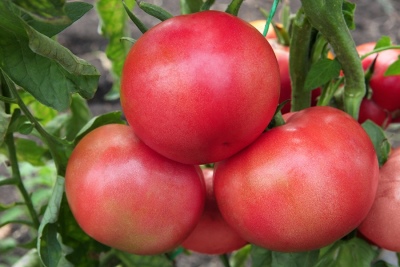
- Category: grade
- Appointment: fresh consumption
- Ripening period: mid-season
- Growing conditions: for open ground, for closed ground
- Bush height, cm: 60-80
- Ripe fruit color: rich mmaline
- Fruit shape: flat-round, slightly ribbed
- Fruit weight, g: up to 400
- Fruit taste: balanced
- Pulp: fleshy, dense
A good ripe tomato is best grown on your own plot, then you can get healthy and tasty vegetables from the bush to the table. The Raspberry Miracle is one of those tomatoes that you should definitely try.
Description of the variety
This is a varietal plant for planting in open and closed ground. Its fruits are consumed exclusively fresh, since they are not suitable for spinning.
Bushes form 60 to 80 cm high. The first inflorescence appears only above the 8th leaf.
The main qualities of the fruit
The Raspberry Miracle is distinguished by a bright, crimson color of ripe fruits, hence the name. Tomatoes grow large, weighing up to 400 grams. The flesh under the skin is dense, fleshy.
Taste characteristics
The taste of tomatoes Raspberry miracle can be described as balanced.
Ripening and fruiting
This is a mid-season tomato.
Yield
Productivity at a decent level.
The timing of planting seedlings and planting in the ground
Seeds can be sown for seedlings in May. The bushes are transplanted into the ground when 4-6 true leaves are formed on them.

Growing tomato seedlings is an extremely important process, because it largely depends on whether the gardener can harvest at all. All aspects must be taken into account, from seedbed preparation to planting in the ground.
Landing scheme
Most often, the standard planting scheme is 40 * 60 cm.

Growing and care
Bushes must be tied up and shaped. It is best to leave one main shoot, then the fruits grow as large as possible.
The garter is carried out to stakes or on trellises. During the rapid growth and development of the plant, it is necessary to pay attention to special supports. A small trellis will do. It is necessary to hammer two pegs on the sides of each bed and pull a thin wire between them. Periodically, for better growth, a little earth is poured under a large bush. On those stems that are underground, small additional roots will begin to form, which will contribute to the best nutrition for the Raspberry Miracle bush.
The main difficulty when sowing seeds in the ground is getting uniform and friendly shoots. To solve this problem, the inoculum is soaked in oxygen-saturated water. Thus, the activity of enzymes inside increases and their friendly germination occurs. Soak tomato seeds in water for about 8 hours.
The soil for the Raspberry Miracle should be prepared in the fall. The site is cleared of large vegetation, tops, stems, fertilized with humus or complex mineral fertilizers. Next, you need to dig it up. In the spring, when the top layer of the prepared soil dries up, it must be loosened.
The planting depth of seeds is 3-4 cm. After planting, to accelerate seedling, you need to compact the soil and cover the rows for several days with foil - which will accelerate the germination of tomato seeds and retain moisture. As soon as the Raspberry Miracle throws out 4-6 true leaves, the seedlings are thinned out, leaving one of the strongest plants.
These tomatoes do not tolerate a cold snap. They are very light-requiring, and they also love moisture. Seedlings are planted in open ground around mid-May. It is best to do this in the evening to avoid direct sunlight.
A tomato bush will be stronger if it has a strong and well-developed root system. This can only be achieved by planting the Raspberry Miracle at the optimum depth. It is determined simply - the entire root ball and another centimeter of the stem must fit into the hole.
After planting, the tomatoes need to be watered very well. Heavy watering should continue for two weeks to stimulate additional root growth. After the Raspberry Miracle tomatoes take root well, they need to be watered abundantly, but infrequently. After the soil dries up, it needs to be loosened.
Further, care consists in timely watering, loosening the soil, processing plants from diseases and pests.
Also, an important role in the cultivation of this variety is played by feeding with organic and mineral fertilizers. The 1st should be carried out 10-15 days after planting the seedlings in the ground (if the tomatoes were planted with seeds, then before flowering). It is best to feed with a solution of mullein or bird droppings (1:10).
The 2nd is carried out at the time of the formation of green fruits. This is done with complex fertilizers (nitrogen, phosphorus and potassium). Fertilizer composition: urea - 10 grams, superphosphate and potassium chloride - 40 grams each. Dilute in a bucket of water and water under a bush at the rate of 1 liter per plant.
Further feeding is carried out as needed, visually inspecting the bushes and fruits. If the plant is dark green and develops well, then you can wait with replenishment, since an excess of fertilizer can harm.
Fertilization is highly effective when planting seedlings in holes, in particular, phosphorus mixtures.
If an insufficient amount of fertilizer was applied in the fall for the cultivation of tomatoes of this variety, or the bushes look underdeveloped, it is worth applying additional nitrogen fertilization.




A plant needs different micronutrients at each stage of growth. All fertilizers can be divided into two groups: mineral and organic. Folk remedies are often used: iodine, yeast, bird droppings, eggshells.
It is important to observe the rate and period of feeding. This also applies to folk remedies and organic fertilizers.
Disease and pest resistance
There is no resistance to the most common diseases and pests. In the first case, treatment with fungicidal agents is carried out, in the second - with insecticides.



























































































